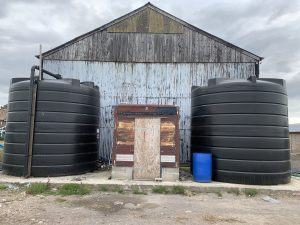Rainwater Recovery for Bird Housing at Brow Farm
 At Brow Farm, our commitment to environmental stewardship goes hand in hand with practical solutions that benefit both our operations and the wider ecosystem. We believe that sustainable farming practices must also contribute positively to our bottom line, ensuring a balanced approach that supports profitability alongside environmental responsibility.
At Brow Farm, our commitment to environmental stewardship goes hand in hand with practical solutions that benefit both our operations and the wider ecosystem. We believe that sustainable farming practices must also contribute positively to our bottom line, ensuring a balanced approach that supports profitability alongside environmental responsibility.
One significant initiative we’ve undertaken is the expansion of our rainwater recovery systems on the farm. These systems play a crucial role in harvesting rainwater efficiently and sustainably, providing multiple benefits across our farm operations.
Existing Rainwater Harvesting
Our existing rainwater harvesting system, which directs rainwater from the roofs of our main farm buildings to a two-acre lake, has been instrumental in supporting irrigation for our salad and vegetable crops. This system, established over a decade ago, represents our early commitment to sustainable water management practices.
Expanding the System
For our latest project, we focused on harvesting rainwater for our bird housing facilities. The roofs of our rearing and breeder sheds, along with the Dutch barn housing yearling birds, now contribute to collecting rainwater. This substantial water collection area ensures a reliable supply for our livestock throughout the year, promoting self-sufficiency and resource optimization.
The Process
To implement this expansion, we strategically designed a low-pressure gravity system that aligns seamlessly with our existing infrastructure, particularly our nipple drinkers used for livestock water supply. Key steps included:
1. Water Storage Setup: We installed two 35,000-liter storage tanks on a concrete plinth at the top of a gentle slope, optimizing gravity flow for water distribution.
2. Filtration and Disinfection: Water from the storage tanks passes through a rigorous filtration process, including a particle filter and a UV (Ultraviolet) light system. This UV treatment is vital for disinfecting water by targeting and neutralizing harmful microorganisms, ensuring safe and high-quality drinking water for our birds.
3. Distribution Control: The cleaned water is directed to header tanks in specific areas like the rearing shed, breeders shed, and stock barn. This segmented distribution enables precise control over water usage, essential for medication administration and overall water management.
Benefits and Environmental Impact
– Sustainable Water Use: By harnessing rainwater, we reduce reliance on external water sources, promoting sustainable water management practices.
– Cost Efficiency: Utilizing rainwater minimizes water costs and helps offset the expenses associated with water supply.
– Environmental Conservation: Reduced water consumption and chemical-free treatment methods contribute to preserving local ecosystems and water resources.
UV Water Treatment
Our UV water treatment system plays a critical role in ensuring water safety. Here’s how it works:
1. UV Lamp: Emits ultraviolet light to penetrate harmful microorganisms in the water.
2. Disinfection Process: Damages microorganisms’ DNA, rendering them inactive and preventing infections.
3. Safe Drinking Water: The treated water meets high safety standards, benefiting both our livestock and the environment.
At Brow Farm, our rainwater recovery initiatives reflect our holistic approach to sustainable farming, blending innovation, environmental care, and operational efficiency for a brighter agricultural future.